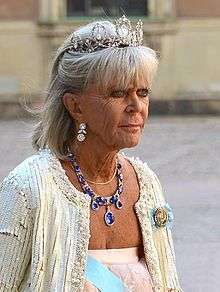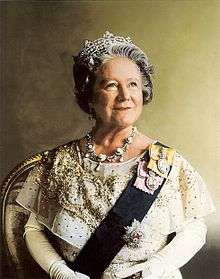Royal family order
A royal family order is a decoration conferred by the head of a royal family to their female relations. Such an order is considered more of a personal memento than a state decoration, although it may be worn during official state occasions.
The tradition is practiced in the royal families of the Commonwealth Realms, Norway, Sweden, Denmark, and Tonga.
Insignia
The badge of a royal family order consists of a portrait of the sovereign set in diamonds, which is suspended from a ribbon. In the United Kingdom, the colour of the ribbon changes with each reign,[1] the only kingdom that has this trait. On the back of the portrait frame is an engraving with the sovereign's monogram.[1] A hidden pin attaches it to the wearer's clothes.
Sweden
Kungens miniatyrporträtt (literally the "King's miniature portrait") is a royal decoration unofficially given to female members of the Swedish royal family. It is similar to the Royal Family Orders of other European monarchies, although the Swedish royal court refers to it as "The King's portrait".[2]
History
The earliest known Swedish Decoration is that of King Oscar II. At that time, Decorations did not have to be attached to the Seraphim blue ribbon that is the case today. As there are no earlier records of royal family decorations in Sweden, it might be assumed that the decorations were not introduced in Sweden until the reign of Oscar II. Queen Sophia started "Sophiahemmet", a Red Cross nurse training program. At the graduation of the nurses, she presented a miniature portrait of the king on a white ribbon with a red cross. On the back was DSF inscribed in gold enamel on blue background.[3] In the 1900s Gustav V and his wife Victoria made a special form of the order with both of them in the portrait as a gift to their friend Countess Anna Brahe (born Anna Nordenfalk) when she visited them.[4] Currently recipients of the order wear it as part of their formal dress, often when their male counterparts wear medals.[5]
 Order with Gustav and Victoria
Order with Gustav and Victoria
Appearance
The decoration currently consists of an oval portrait of King Carl XVI Gustaf half length. There are different versions of the portrait of the King, where he is dressed in admiral's uniform or simply formal wear with either the Seraphim band or chain. The portrait is framed by brilliant-cut diamonds and a brilliant bow at the portrait above page. The portrait is attached to a bow in Seraphim light blue ribbon and is held to the person's attire with a pin that is not seen. Different designs of the frame exist: some are more decorated than others.
Recipients
From King Oscar II
_c_1872_(2).jpg) Sofia of Nassau wearing the order of Oscar II
Sofia of Nassau wearing the order of Oscar II
From King Gustaf V
- Queen Victoria, Queen Consort[6] - (Wife)
- Queen Sophia, Queen Mother[7] - (Mother)
- Queen Ingrid, Queen Consort of Denmark[8][9] - (Granddaughter)
- Crown Princess Margaret[10] - (1st eldest Daughter-In-Law)
- Grand Duchess Maria Pavlovna[11][10] - (2nd Daughter-In-Law)
- Queen Louise - (2nd eldest Daughter-In-Law)
- Princess Sibylla, Duchess of Vasterbotten[12] - (Granddaughter-In-Law)
From King Gustaf VI Adolf
- Queen Louise, Queen Consort (Wife)
- Queen Ingrid, Queen Mother of Denmark[13] - (Daughter)
- Princess Margaretha, Mrs. Ambler[14][15] - (Granddaughter)
- Princess Birgitta[15] - (Granddaughter)
- Princess Désirée, Baroness Silfverschiöld[15] - (Granddaughter)
- Princess Christina, Mrs. Magnuson[16] - (Granddaughter)
- Princess Sibylla, Duchess of Vasterbotten[17][18] - (Daughter-In-Law)
From King Carl XVI Gustaf
- Princess Margaretha, Mrs. Ambler[19][20] (1st eldest sister)
- Princess Birgitta[21] (2nd eldest sister)
- Princess Désirée, Baroness Silfverschiöld[22][19] (3rd eldest sister)
- Princess Christina, Mrs. Magnuson[23] (4th elder sister)
- Queen Ingrid, Queen Dowager of Denmark[24] (Aunt)
- Queen Silvia, Queen Consort (wife)[25]
- Crown Princess Victoria[25] (1st daughter)
- Princess Madeleine, Duchess of Halsingland and Gastrikland[25] (2nd daughter)
- Princess Lilian, Duchess of Halland[26] (Aunt by marriage)
- Princess Sofia, Duchess of Värmland[27][28] (Daughter-In-Law)
- Alice Trolle-Wachtmeister[29][30] (Royal Court Member)
_2.jpg) Queen Silvia wearing her order.
Queen Silvia wearing her order.- Princess Madeleine wearing her order.
 Princess Birgitta wearing her order.
Princess Birgitta wearing her order..jpg) Princess Christina, Mrs. Magnuson, wearing her order.
Princess Christina, Mrs. Magnuson, wearing her order.
Denmark
.jpg)
After the banishment of the adulterous Queen Caroline Mathilde on 17 January 1772 the Royal Danish Court needed a new decoration to replace the Order of Matilde. King Christian VII of Denmark founded this order on 21 October 1774 as a new decoration that was solely meant for the Danish Royal Family. It was awarded to gentlemen and ladies. The men wore the insignia detached from a ribbon on the left side of the breast. The ladies wore the same insignia on a bow of the same ribbon on their left shoulder.
After the death of Queen-Dowager Juliana Maria in 1796 the order fell into disuse. In 1912 when King Christian X ascended to the throne this order was restored keeping to the present time.
- Order of Christian VII (1774-1796)
- Order of Christian X (1912-1947)
- Order of Frederik IX (1947-1972)
- Order of Margrethe II (1972)
Norway
- Royal Family Order of King Haakon VII of Norway (1906-1957)
- Royal Family Order of King Olav V of Norway (1957-1991)
- Royal Family Order of King Harald V of Norway (1991-current)
United Kingdom

The first Royal Family Order was issued during and after the regency of King George IV of the United Kingdom. Prior to 1820, he started the practice of presenting the badge of the order to ladies and gentlemen of the Court, particularly female members of the Royal family. An ornate frame of diamond oak leaves and acorns surrounded his portrait, suspended from a white silk bow which varied for men and women. As a girl, Princess Alexandrina of Kent (later Queen Victoria) received this badge from her uncle.
Royal Family Orders
- Royal Family Order of King George IV (1821)
- Royal Order of Victoria and Albert (1862)
- Royal Family Order of King Edward VII (1901)
- Royal Family Order of King George V (1911)
- Royal Family Order of King George VI (1937)
- Royal Family Order of Queen Elizabeth II (1953)
References
- "ODM of the United Kingdom: Royal Family Orders". Medals.org.uk. 2007-04-02. Retrieved 2016-06-02.
- "The King presents the 2010 Nobel Prizes - Sveriges Kungahus". Kungahuset.se. Retrieved 2016-06-02.
- "Drottning Sofia" (PDF). Livrustkammaren.se. Retrieved 13 June 2014.
- "Porträtt". Retrieved 14 June 2014.
- "About the images in formal dress". Retrieved 14 June 2014.
- "Victoria of Baden wearing a choker necklace | Grand Ladies | gogm". Gogmsite.net. 2010-09-04. Retrieved 2016-06-02.
- File:Sofia of Sweden (1857) c 1900.jpg
- "Photographic image : 18 years old in court robe" (JPG). 2.bp.blogspot.com. Retrieved 2016-06-02.
- "Photographic image" (JPG). 1.bp.blogspot.com. Retrieved 2016-06-02.
- "1905 Swedish royal family by ? | Grand Ladies | gogm". Gogmsite.net. 2012-05-20. Retrieved 2016-06-02.
- "Princess Willem of Sweden , née Grand duchess Maria Pavlovna, the younger, in a traditional swedish court gown. 1910s. | Maria Pavlovna | Pinterest | Sweden, T…". Pinterest.com. Retrieved 2016-06-02.
- "Photographic image" (JPG). Sverigesradio.se. Retrieved 2016-06-02.
- "Photographic image" (JPG). Theroyalforums.com. Retrieved 2016-06-02.
- "Princess Margaretha of Sweden with her mother Princess Sibylla | Royals - Sweden 1 - FULL | Pinterest | Sweden, Princesses and Mothers". Pinterest.com. Retrieved 2016-06-02.
- "Photographic image" (JPG). Theroyalforums.com. Retrieved 2016-06-02.
- "Photographic image". 41.media.tmblr.com. Archived from the original (JPG) on 2016-03-04. Retrieved 2016-06-02.
- "Photographic image" (JPG). Migrated.ifokus.se. Retrieved 2016-06-02.
- "Photographic image" (JPG). S-media.ak0/pinimg.com. Retrieved 2016-06-02.
- "Archived copy". Archived from the original on July 9, 2015. Retrieved September 6, 2015.CS1 maint: archived copy as title (link)
- "Photographic image" (JPG). Y.cdn-expressen.se. Retrieved 2016-06-02.
- "Photographic image" (JPG). Cdn3.cdnme.se. Retrieved 2016-06-02.
- "Photographic image" (JPG). 41.media.tumblr.com. Retrieved 2016-06-02.
- "Photographic image : Prinsessan Christin" (JPG). Upload.wikimedia.org. Retrieved 2016-06-02.
- "ROYALTY AND POMP (THE WEDDING H.M. King Carl XVI Gustaf of Sweden...)". Royaltyandpomp.tumblr.com. Retrieved 2016-06-02.
- "The King presents the 2012 Nobel Prizes - Sveriges Kungahus". Kungahuset.se. Retrieved 2016-06-02.
- "Photographic image" (JPG). Kungligamodelbloggen.svenskdam.se. Retrieved 2016-06-02.
- "Royals & Fashion: Baptême du prince Nicolas de Suède | I Want to be a Princess..or a Queen | Pinterest | Prince, Royals and Fashion". Pinterest.com. Retrieved 2016-06-02.
- "Baptism of Prince Nicolas at the Royal Chapel in Drottningholm Palace on October 11, 2015. | Royalty -Sweden | Pinterest | Baptisms, Palaces and Prince". Pinterest.com. Retrieved 2016-06-02.
- "Photographic image" (JPG). 2.bp/blogspot.com. Retrieved 2016-06-02.
- "Här är de skånska slotten där det spökar | Kvällsposten". Expressen.se. 2014-11-01. Retrieved 2016-06-02.